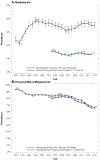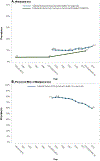Cannabis use, attitudes, and legal status in the U.S.: A review
- PMID: 28705601
- PMCID: PMC6348863
- DOI: 10.1016/j.ypmed.2017.07.008
Cannabis use, attitudes, and legal status in the U.S.: A review
Abstract
Cannabis is widely used among adolescents and adults. In the U.S., marijuana laws have been changing, and Americans increasingly favor legalizing cannabis for medical and recreational uses. While some can use cannabis without harm, others experience adverse consequences. The objective of this review is to summarize information on the legal status of cannabis, perceptions regarding cannabis, prevalence and time trends in use and related adverse consequences, and evidence on the relationship of state medical (MML) and recreational (RML) marijuana laws to use and attitudes. Twenty-nine states now have MMLs, and eight of these have RMLs. Since the early 2000s, adult and adolescent perception of cannabis use as risky has decreased. Over the same time, the prevalence of adolescent cannabis use has changed little. However, adult cannabis use, disorders, and related consequences have increased. Multiple nationally representative studies indicate that MMLs have had little effect on cannabis use among adolescents. However, while MML effects have been less studied in adults, available evidence suggests that MMLs increase use and cannabis use disorders in adults. While data are not yet available to evaluate the effect of RMLs, they are likely to lower price, increase availability, and thereby increase cannabis use. More permissive marijuana laws may accomplish social justice aims (e.g., reduce racial disparities in law enforcement) and generate tax revenues. However, such laws may increase cannabis-related adverse health and psychosocial consequences by increasing the population of users. Dissemination of balanced information about the potential health harms of cannabis use is needed.
Keywords: Cannabis; Epidemiology; Marijuana; Medical marijuana; National surveys.
Copyright © 2017. Published by Elsevier Inc.
Conflict of interest statement
Conflict of interest disclosures
Dr. Hasin is Principal Investigator of a validity study of a measure of addiction to prescription opioids funded by InVentive Health Consulting, which combines support from nine pharmaceutical companies. All other authors have no conflicts of interest.
Figures
References
-
- Aldrich MR, Mikuriya T, 1988. Savings in California marijuana law enforcement costs attributable to the Moscone Act of 1976-a summary. J. Psychoactive Drugs 20,75–81. - PubMed
-
- American College of Obstetricians and Gynecologists Committee on Obstetric Practice, 2015. Committee opinion no. 637: marijuana use during pregnancy and lactation. Obstet. Gynecol. 126, 234–238. - PubMed
-
- American Psychiatric Association, 2013. Diagnostic and Statistical Manual of Mental Disorders. 5th ed American Psychiatric Publishing, Arlington, VA.
-
- Angrist JD, Pischke J-S, 2008. Mostly Harmless Econometrics: An Empiricist’s Companion. Princeton University Press.
-
- Annas GJ, 1997. Reefer madness-the federal response to California’s medical-marijuana law. N. Engl. J. Med. 337, 435–439. - PubMed
Publication types
MeSH terms
Substances
Grants and funding
LinkOut - more resources
Full Text Sources
Other Literature Sources



